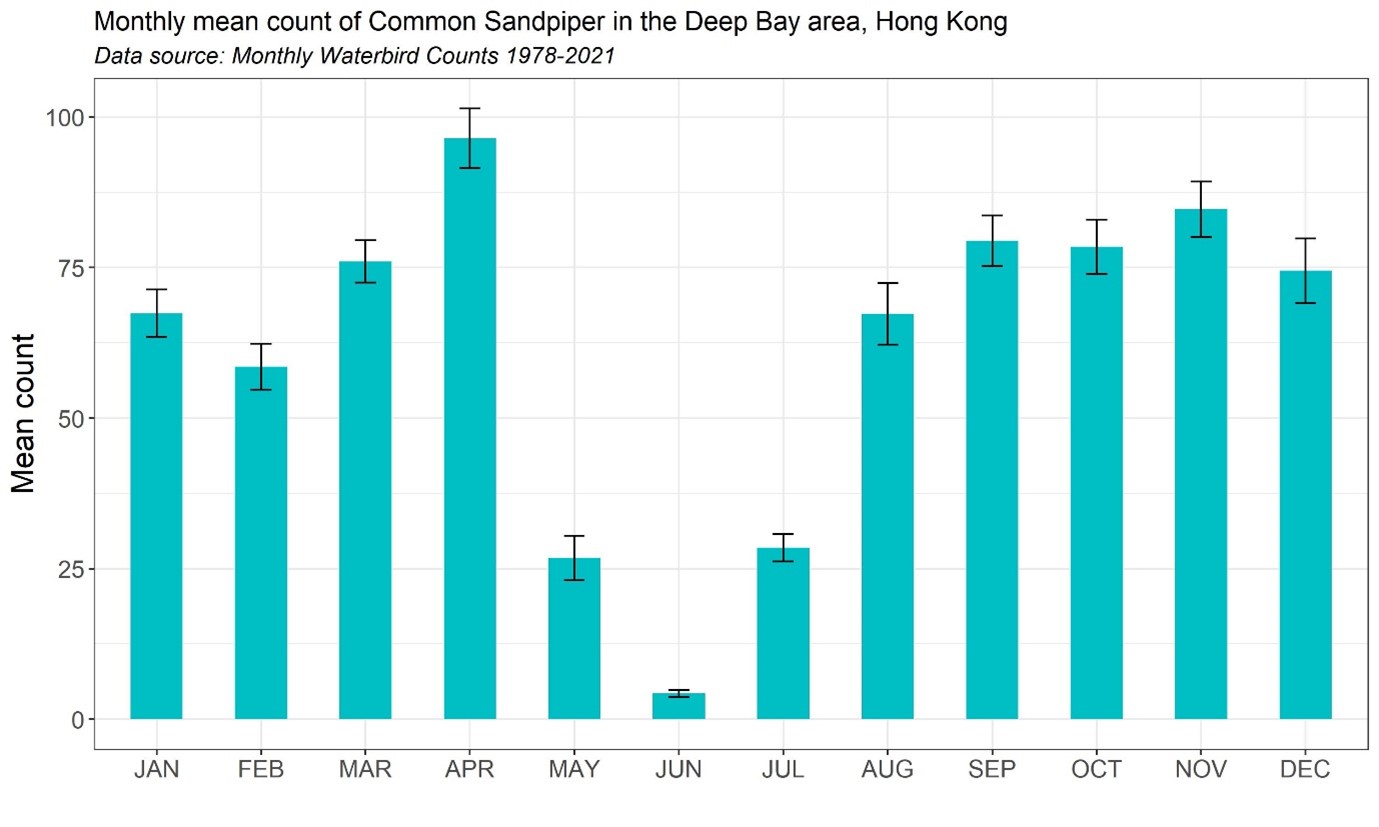Common Sandpiper Actitis hypoleucos 磯鷸
Category I. Common passage migrant and winter visitor, rare in summer; occurs in a wide variety of freshwater wetlands.
IDENTIFICATION

Oct. 2008, FUNG Hon Shing. Juvenile.
19-21 cm. More than many other wader species, behaviour and movements identify Common Sandpiper more than plumage. In flight it has a distinctive staccato style of rapid, shallow wing beats on depressed wings interspersed by short glides. When foraging it habitually bobs its rear end up and down at intervals and adopts a crouched posture. Plumage is rather plain, brown above and on the chest with white underparts and yellowish legs; a short whitish supercilium is more obvious over the lores. In flight shows white wing bar. Juveniles (such as the bird illustrated) have more obvious markings above, especially on wing coverts and tertials.
VOCALISATIONS
Usually, a series of two or more high-pitched notes rapidly uttered in a somewhat breathless manner and falling in pitch slightly as the call progresses.
The alarm call is a long whistle that rises slightly in pitch and has a clipped ending
DISTRIBUTION & HABITAT PREFERENCE
Common Sandpiper occurs in a wide variety of coastal and low-lying wetlands throughout HK, though primarily in the northwest New Territories. Highest numbers appear to be in fish pond areas where the bare banks of ponds afford opportunities for foraging at the water’s edge.
OCCURRENCE
Data from monthly waterbird counts since 1978 (Figure 1) indicate that in the Deep Bay area Common Sandpiper is a most numerous in April, but that passage is more prolonged in autumn, lasting from August to November. Numbers fall midwinter due to either emigration during the coldest part of the year and/or natural mortality, while spring passage is evident again in March. Fewest birds occur in June. The highest count on the HK side of Deep Bay in these surveys is 152 on 14 April 2002 (two further birds were at Shenzhen). Based on winter waterbird counts in Deep Bay Sung et al. (2021) concluded that the wintering population of Common Sandpiper in HK declined from 1998 to 2017.
Systematic counts at the former airport at Kai Tak during 1974-79 revealed that spring passage was evident by the second week of March, and there were possibly two peaks of passage. The first of these occurred during the second half of March and first week of April, and the second, the highest of the year, occurred during the last week of April and the first week of May. Passage remained relatively strong until the third week of May but declined sharply thereafter. Lowest numbers occurred in June and the first three weeks of July. Autumn passage was apparent by the last week of July, rising to a peak during September and October followed by a decline to a low in late January and early February. Allowing for the differences in habitat and location, it would appear that there has been no significant change in the pattern of occurrence of Common Sandpiper in the interim.
During midsummer, a count of 20 at San Tin on 6 July 1980 is exceptional, as all others primarily involve one or two birds. The highest single locality winter count away from Deep Bay is the remarkable total of 100 at Hebe Haven on 16 February 1985.
Vaughan and Jones (1913) stated that Common Sandpiper was a winter visitor, but that some were ‘resident’; most birds occurred from September to April. Dove and Goodhart (1955) noted it regularly from 25 July to 24 May and occasionally in summer. On passage they were seen in paddy fields and other areas not frequented during the winter.
BEHAVIOUR, FORAGING & DIET
Forages at water’s edge or on wet or dry mud locating prey visually, sometimes running quickly between short periods of standing still. Although generally seen foraging alone and habitually defending feeding territories, Common Sandpipers will come together to form roosts overnight, and it is common to see pre-roost gatherings or small vocal flocks flying around at dusk. An example of this is a pre-roost gathering of 55 birds at Mai Po NR on 21 January 2016. In addition, during migration flocks of birds may occur in unusual locations; for example, a flock of at least 50 were present on Po Toi on 24 April 2006, while 25 were on rocks at Cheung Chau on 29 April 1999. Migration at night over Sai Kung has been recorded.
RANGE & SYSTEMATICS
Monotypic. Breeds across much of the Palearctic between 35oN and 70oN from western Europe to Kamchatka; winters in parts of western Europe and north Africa, but mainly from sub-Saharan Africa east through the Middle East and the Indian subcontinent to Indochina, south China and southeast Asia down to Australia (Van Gils et al. 2020). In China breeds in the northwest and northeast, and winters in the southern half of the country, including Taiwan and Hainan (Liu and Chen 2020).
CONSERVATION STATUS
IUCN: Least Concern. Population trend decreasing.
Figure 1.

Dove, R. S. and H. J. Goodhart (1955). Field observations from the Colony of Hong Kong. Ibis 97: 311-340.
Liu, Y. and Y. H. Chen (eds) (2020). The CNG Field Guide to the Birds of China (in Chinese). Hunan Science and Technology Publication House, Changsha.
Van Gils, J., P. Wiersma, and G. M. Kirwan (2020). Common Sandpiper (Actitis hypoleucos), version 1.0. In Birds of the World (J. del Hoyo, A. Elliott, J. Sargatal, D. A. Christie, and E. de Juana, Editors). Cornell Lab of Ornithology, Ithaca, NY, USA. https://doi.org/10.2173/bow.comsan.01
Sung, Y. H., C. C. Pang, T. C. H. Li, P. P. Y. Wong and Y. T. Yu (2021). Ecological Correlates of 20-Year Population Trends of Wintering Waterbirds in Deep Bay, South China. Frontiers in Ecology and Evolution. Published 20 April 2021 doi: 10.3389/fevo.2021.658084
Vaughan, R. E. and K. H. Jones (1913). The birds of Hong Kong, Macao and the West River or Si Kiang in South-East China, with special reference to their nidification and seasonal movements. Ibis 1913: 17-76, 163-201, 351-384.

